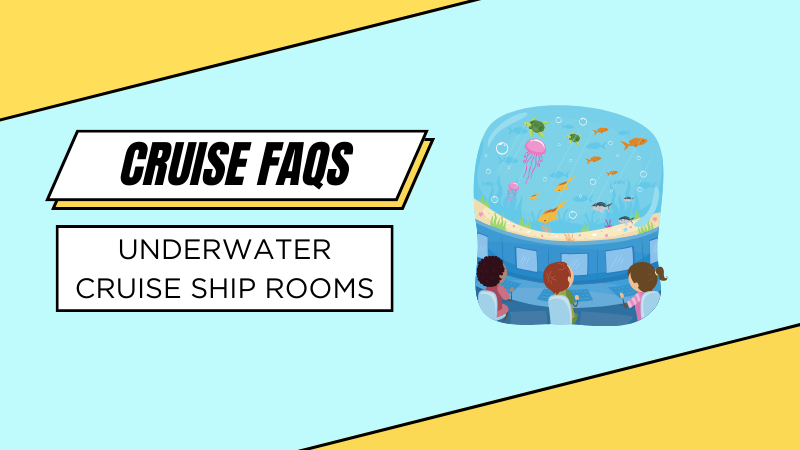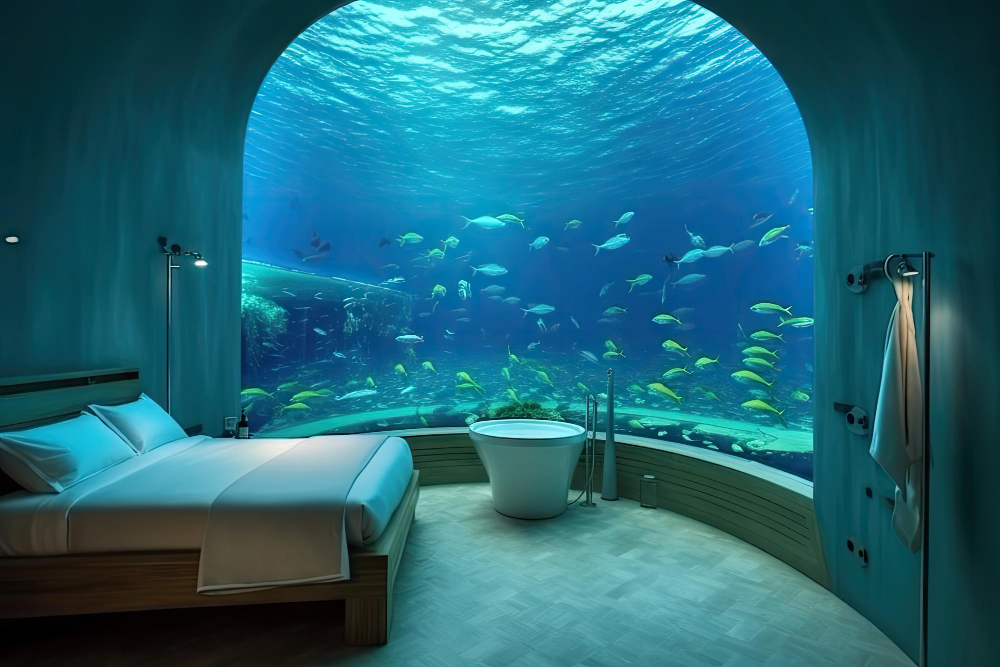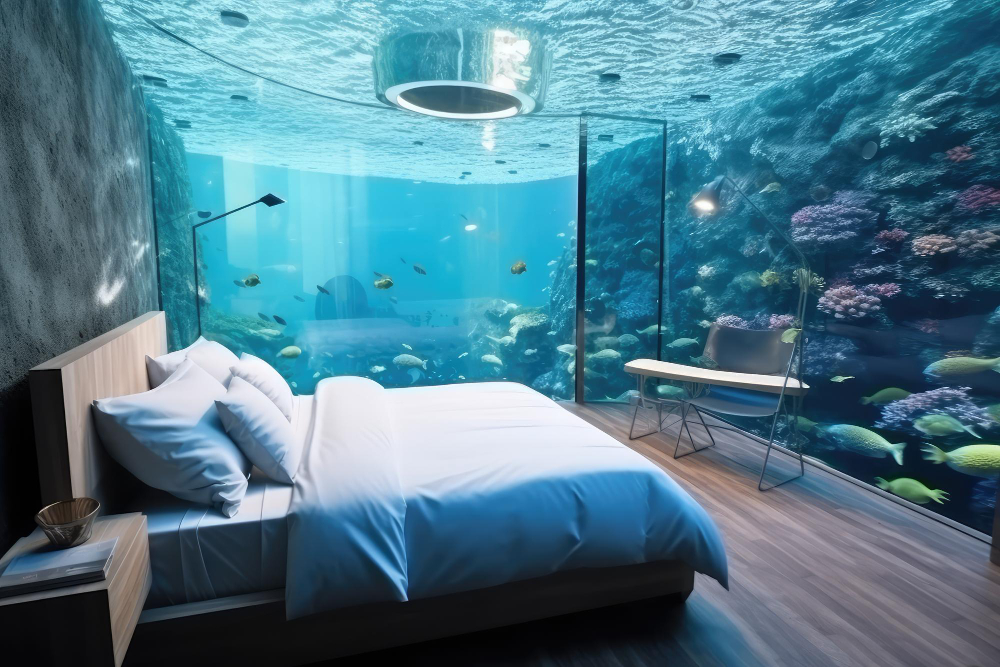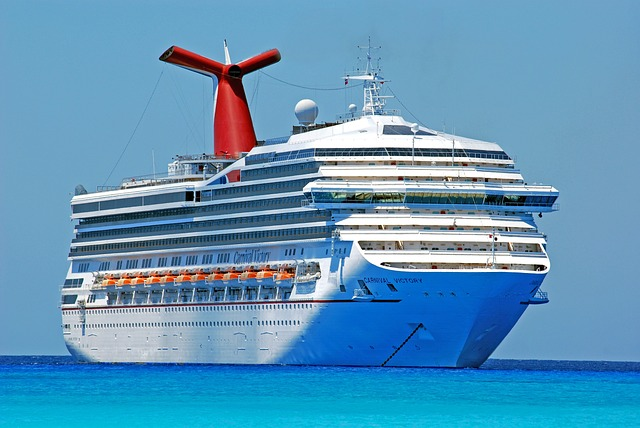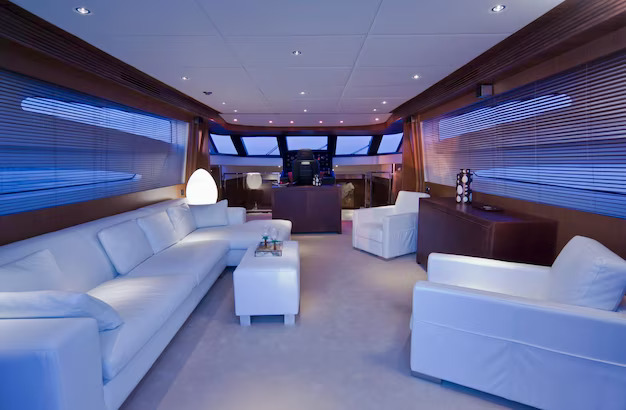Imagine sailing in the open ocean, surrounded by nothing but azure waves and distant horizons. Now, picture going to bed and waking up beneath the water, greeted by a mesmerizing display of marine life swimming right past your window. Underwater cruise ship rooms take your cruise experience from the deck to the depths, offering a unique twist on traditional cruise accommodations.
But have you ever wondered what it’s like below deck? Understanding the layout of cruise ships below the waterline not only satiates your curiosity but also reveals a world you might never have known existed. So, come aboard as we delve into the enigmatic world of underwater cabins, lounges, and more.
Do Underwater Cruise Ship Rooms Exist?
The concept of underwater cruise ship rooms often conjures images straight out of a science fiction movie—think luxurious suites surrounded by a 360-degree view of the ocean’s depths. However, let’s dispel the myths and unfold the reality. Contrary to popular belief, traditional ocean cruise ships generally don’t offer underwater rooms where you can sleep surrounded by marine life.
So, what’s actually below the waterline? Well, that would typically include engine rooms, storage rooms, and crew cabins. These essential areas keep the ship running smoothly and are far from the plush underwater suites one might imagine.
However, the industry is evolving, and some specialized cruise lines are pushing the envelope by offering underwater lounges like the Blue Eye Lounge where passengers can at least experience the underwater world without donning a scuba suit. While not a room to sleep in, these lounges do offer an enchanting glimpse of what lies beneath, filling the gap between fantasy and reality.
A Glimpse Below Deck: What Really Resides Underwater
Now that we’ve cleared the air—or rather, the water—about the existence of underwater cruise ship rooms, you might be wondering what actually exists below deck. The underbelly of a cruise ship is a hive of activity and essential services, all submerged beneath the ocean’s surface.
Understanding the elements below the waterline gives you a newfound appreciation for the intricate details that go into making your cruise experience smooth and enjoyable. So let’s set sail into the nitty-gritty of what resides underwater on these impressive maritime marvels.
What Proportion of a Cruise Ship Is Submerged in Water?
If you’re wondering how much of a cruise ship is actually underwater, it’s more than you might think. Generally, about 40% of the ship depending on the height of the ship (the larger, the lesser), is submerged below the water line, a vital area of a cruise vessel that supports the operations and well-being of everyone on board.
Cruise Rooms Below the Waterline
When the topic of underwater cruise ship rooms pops up, it’s easy to let your imagination run wild. However, what actually lies below the waterline is much more pragmatic than picturesque. The areas underneath are built for functionality and practicality, designed to keep the ship running smoothly. Here’s a closer look at what you’ll find:
Engine Rooms
The engine rooms serve as the beating heart of any cruise ship. This area is crucial for the ship’s overall operations, powering everything from the vessel’s propulsion systems to the electricity keeping the lights on and air conditioning running. Ensuring this space is functioning correctly is vital for the safety and enjoyment of both passengers and crew members alike.
Crew Cabins
Speaking of crew members, their accommodations, known as crew cabins, are usually situated below deck. Here, the various crew bar staff can rest and recharge after working tirelessly to provide guests with an unforgettable experience. These rooms are not designed for luxury but rather for utility, allowing the crew quick access to essential ship areas.
Storage Rooms
Next up are the storage rooms, the unsung heroes of the cruise ship. These spaces are extremely necessary for storing a range of products, including food, drinks, cleaning supplies, and replacement components. It’s these behind-the-scenes areas that ensure the ship stays well-stocked for the entirety of the journey.
Utility Rooms
Utility rooms class ships are a different beast altogether. These spaces house the technology and systems needed for water treatment, waste management, and other functionalities that help the ship stay environmentally responsible. By treating waste and purifying water, these rooms play a crucial role in minimizing the vessel’s impact on the marine environment.
Lower Decks
Last but not least, the lower decks are a combination of several of these elements. Often, you’ll find that these decks house not just engine rooms and other utility rooms and spaces but also communal areas for the crew, like crew bars, adding a little leisure to the mix of functionality.
So while the idea of underwater rooms for passengers may sound intriguing, the real story below deck is one of practicality and essential functions that keep the cruise ship operating seamlessly.
While you might not find the luxury of an underwater cruise ship room down here, you’ll find the backbone of what makes your above-water experience so seamless and enjoyable. As the industry innovates, who knows what could be next? Perhaps the vision of sleeping with fishes—figuratively, of course—might one day become a reality.
The Intricacies of Ship Design
While the notion of underwater cruise ship rooms may seem tantalizing, their absence in mainstream cruise line offerings is rooted in critical design intricacies that prioritize safety and structural integrity. Placing passenger rooms below the waterline could severely impact the ship’s overall balance and buoyancy, leading to navigation difficulties and safety risks.
Moreover, in the event of an emergency like a hull breach, underwater rooms could complicate rescue and evacuation efforts. Creating a stable, pressurized environment for such rooms would also pose additional engineering challenges that go far beyond conventional shipbuilding. For these reasons, cruise lines tend to focus on enhancing the onboard experience above the water, while reserving the area below for essential operational components.
Unique Exceptions: The Blue Eye Lounge
While traditional underwater cabins may still be the stuff of dreams, there’s one notable exception that brings us a step closer to the underwater fantasy: the Blue Eye Lounge. This pioneering venture in maritime luxury offers passengers a rare glimpse into the underwater world without requiring them to leave the ship.
What sets the Blue Eye Lounge apart isn’t just its submerged locale; it’s the multisensory experience it offers. Imagine sitting in a state-of-the-art lounge with underwater windows that provide live images from three underwater cameras, strategically placed to capture the most awe-inspiring marine sights.
The Blue Eye experience goes beyond mere visual spectacle. It employs a marine surround sound system that pipes in the very sounds of the sea around you. Through hydrophones and specialized underwater microphones, the lounge captures the acoustic environment of the deep sea, allowing passengers to hear marine life such as dolphins and whales in their natural habitat.
From the visual brilliance of marine life from the underwater window to the auditory magic of the ocean’s depths, the Blue Eye Lounge offers an immersive underwater experience unlike any other, bridging the gap between our wildest imaginations and the compelling reality beneath the waves.
Underwater Options in River Cruises
When it comes to the allure of underwater accommodations, river cruises present a different set of opportunities and limitations compared to ocean cruises. While traditional ocean cruises generally shy away from underwater passenger spaces for many rooms the reasons we’ve discussed, river cruises offer something akin to the experience, albeit with a twist.
River Cruise Cabin Types
In river cruises, you’ll often find ‘river view’ rooms onboard accommodations that technically sit below the waterline but feature windows strategically positioned just above it. Take Viva Cruises, for instance, where cabins below the water level are not uncommon. While standing, the windows in these cabins would be around head height, giving passengers a unique viewpoint just above the water’s surface.
However, it’s essential to set your expectations accordingly. These rooms offer views of the river’s surface but do not immerse you in an underwater world teeming with marine life. Because they don’t offer the full underwater spectacle, these rooms are often some of the most budget-friendly options available on a river cruise.
So, if you’re looking to dip your toes into the world of semi-submerged accommodations without breaking the bank, a river cruise might just offer the experience you’re after—even if it’s not quite the same as sleeping with the fishes.
Why Don’t More Cruise Ships Offer Underwater Views?
The allure of underwater cruise ship rooms is undeniable, but why isn’t this a standard offering across cruise lines? Several key factors contribute to the absence of these underwater wonders on most ships.
Technological and Safety Barriers
- Construction Costs: One of the primary hurdles is the enormous expense involved in developing underwater cabins. Beyond the regular construction of cruise ship rooms, underwater options would require specialized materials and technology to maintain structural integrity and safety.
- Safety Concerns: As discussed in earlier sections, situating rooms below the sea level or the water line poses significant safety risks. In the event of a hull breach, rooms located underwater would be extremely dangerous and complicate evacuation procedures. This is a significant concern for cruise lines and their crew members who are responsible for the safety of all passengers.
- Quality of the Underwater View: While the idea of being submerged might sound fascinating, the actual underwater view can often be less than spectacular, depending on the region, water clarity, and marine environment. Unlike the Blue Eye Lounge, which has the luxury of underwater cameras and hydrophones, an underwater room could offer little more than a murky view for most of the journey.
- Maintenance Issues: An often-overlooked concern is the maintenance required for these rooms. Whether it’s ensuring the structural integrity of underwater windows or the upkeep of the underwater lounge, the ongoing costs and efforts are substantial.
In summary, while underwater viewing options like the Blue Eye Lounge or certain river cruise rooms do exist, they are exceptions rather than the rule. The practical challenges and costs associated with underwater cabins remain high, explaining why they are not more commonly featured across cruise lines.
Conclusion
While the allure of underwater cruise ship rooms might captivate our imaginations, the reality is far more functional yet equally fascinating. From the engine rooms that power the vessel to the crew cabins where the staff rest, the underwater portions of cruise ships are built for practicality, not luxury. But don’t be disheartened—options like the Blue Eye Lounge offer unique glimpses into the underwater cruise lounge world, serving as exciting alternatives.
Understanding the ship’s design can greatly enrich your cruise experience, providing insights into the marvels of engineering and marine life that make your voyage possible. In essence, what lies below the deck may not be what you envisioned, but it’s certainly worth discovering.
FAQs
Are there any rooms underwater on a cruise ship?
While the idea of underwater cruise ship rooms is captivating, they generally don’t exist. What you’ll find underwater are essential areas like engine rooms and crew cabins. Some ships offer specialized lounges like the Blue Eye Lounge for a quasi-underwater experience, but true underwater rooms are not common.
Are all rooms on a cruise ship above water?
Most passenger rooms or cabins on cruise ships are located above the waterline. Despite occasional news headlines, the occurrence of cruise ships sinking is exceedingly rare, thanks to rigorous safety measures and navigation protocols.
The areas one cruise line has below the waterline are typically reserved for practical operations like engine rooms, storage spaces, and crew cabins. Some river cruises offer “river view” rooms that are below but near the waterline.
How many floors are below water on a cruise ship?
Depending on the cruise ship’s architecture, there may be a different number of underwater floors. Generally, about 25-30% of a cruise ship is below the waterline. These lower decks house crucial elements like the engine room, utility rooms, and storage spaces that help keep the ship running smoothly.
Is deck 3 underwater?
The location of Deck 3 depends on the ship’s design, but it’s usually above or around the waterline. On most cruise ships, the first few decks are reserved for operational needs, and passenger decks start just above the waterline. Always check the ship’s specific layout to be sure.

